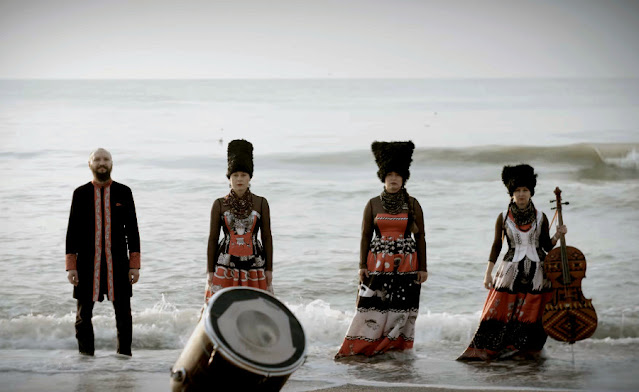Deconstructing Tradition: The Art of Faig Ahmed - Robert Mead
Faig Ahmed dismantles and reforms Azerbaijani traditions of carpet making, creating remarkable new works of contemporary art. Through his art practice he reconsiders these ancient crafts and their history by deconstructing both their physical form and their traditions, and questions the conventions associated with their craft by repositioning them in the contemporary art environment. From these ancient objects he creates new visual forms which challenge the role of iconic cultural objects in representing nations, traditions and history. The cultural significance of carpet weaving in Azerbaijan is reaffirmed by Ahmed’s practice who sees cultural history as a monolithic subject by which we establish our perspectives and visual vocabulary today but also something which is important to question and challenge.
Azerbaijani carpets are extraordinary and intricate creations dating back as far back as to the 2nd millennium BC. They are made up of range of schools defined by their geographic origins and type of pattern and their construction demands an exceptional level of skill. Ahmed has both manipulated original carpets; un-weaving them and using digital technology to redesign and reconstruct them and also employed those equipped with the ancient skills to weave completely new carpets. Finding traditional weavers to craft his designs proved difficult due to sacred nature of the craft but eventually he found those who would be willing to work for him, although in secret. Through these methods Ahmed questions the role of truth in these carpets and whether in a deconstructed form they can they still carry the same significance and power as they did when objects of antiquity. His work shows how artworks can be contemporary but still retain a sense of an ancient aura. They are a unique collision of traditional crafts, steeped in history and digitally distorted and pixelated images. In his work ‘Oiling’ (2012) his hand-woven carpet gives the sensation that the coloured strands of the rug are melting, both digitally and also like the reflective pattern of oil in water. This sensation resonates with Ahmed’s home, Azerbaijan capital Baku, and its own history of early oil drilling and the geopolitics around oil that would follow. The elevation of these carpets into complex art objects, hanging in gallery environment, highlights their journey from their original function as a domestic feature - to be walked over and how, through the role of antiquity and now as contemporary art objects, they have changed into cultural objects that are exhibited and capable of holding multiple meanings. This transformation from functional to iconic is highlighted by their manipulation into abstracted and digitally fluent forms with echoes of contemporary internet art. These digital manipulations express a three-dimensionality and re-activate and invigorate them. They draw the viewer in; as at first glance the skilful weaving of coloured strands appear as pixels seen at close range or a digital glitch.
In manipulating and appropriating the carpets Ahmed moves between a detached and objective use of what are charged iconic source materials and an awareness of the emotional relationship to the stories of their past. There is a strange moral tension in this process of using an object, firstly of function, yet which has become renowned as a historic artefact and transforming it into a contemporary art object for exhibition. Ahmed would pursue carpets aged around 100 years old or more, using his own supplier to acquire theses cultural icons. He has reflected on the morality of this process – attempting to remain detached from their historic weight and tradition simply seeing it as another part of history – and another material or medium for an artist to manipulate. However, he has struggled to always maintain this distance; on one occasion he was using a carpet from the Karabakh school, developed in lowland and mountainous parts of the Karabakh region. Ahmed has reflected on the issues of tradition and its intersection with nationality and sovereignty with this particular carpet. The Karabakh region is occupied by Armenia and the carpet came from a woman who cannot return there. This relationship between the icon and the displacement of its owner caused Ahmed to be unable to cut and appropriate the carpet, describing himself as ‘a hostage to tradition’. Unable to unravel the carpet himself he used an art production company to do so. This gave Ahmed the realisation that despite his best efforts it was not always possible to remain impersonal to tradition and its presence can be felt directly and personally. In turn this has given him a sense of responsibility and morality in how he makes his work. The reuse and negotiation of tradition through careful and considered manipulation can contribute a new truth to the works and retain or reaffirm the power present in the carpet.
In some of his most recent work Ahmed has begun to question the potential of the carpet as not just part of a singular culture but a wider transcendental visual experience. Travelling deep into the Amazon rainforest he has visited the Shipibo-Conibo people to study their carpet making. While carpets from cultures around the world may share some similar patterns, the Shipibo’s carpets are highly unusual as their designs are devised from shamanic visions produced by consuming the hallucinogenic herb ayahuasca. For Ahmed this approach to carpet making offers a natural continuation of the abstracted reimagining of the Azerbaijani schools moving towards a more cosmic or universal language of pattern. The influence of this research can be seen in recent work such as In Liberation I (2018) which includes three psychedelic designs inspired by the Shipibo-Conibo where pieces disintegrate into a plume of red strands. In this work we have the sense that Ahmed carpets are becoming more alive than ever, almost organically growing these new forms out of the old carpets material. A constant rebirth from the old artefact.
Ahmed’s work represents a continuous iconoclasm and reassertion of cultural heritage. This ability to both respect and reimagine national cultural icons is a valuable concept for the contemporary environment: a model for how we appropriate images in the internet age applied to one of the oldest and most monumental visual crafts. The human desire for a strong, immortal national iconography can come from a greater anxiety and fear of the loss of sovereignty of a nation state. What Ahmed shows us is that the power of our cultural history is not lost when it is reformed and a hidden truth can be revealed from the delicate deconstruction of history and craft in the contemporary environment. His carpets are no less majestic or powerful through their digital mutation and in fact allow us to reconsider and value the origins of their labour and their craft again today, highlighting the remarkable history and skill in their creation. The ancient is reaffirmed in the present and while nations attempt to simplify and secure their identity, as something based in a truth of the past, it reminds us that being able to question and rethink what our history is can lead to new forms and futures.
Written and researched by Robert Mead, Published in OCA Magazine in 2019
This article has been written by Robert Mead, Honorary Research Associate and PhD candidate at the Slade School of Fine Art, UCL on behalf of The NO Collective for the ‘InAzerbaijan’ educational project.
InAzerbaijan is a project that aims to widen the knowledge of Azerbaijan and it’s culture in the UK through a web portal and free downloadable high quality educational resources and participatory projects. The web portal has been created by, and for, young people. This article aimed at further and higher education art students can be accessed at: www.inazerbaijan.co.uk.
This project has been created in support of The CSSN Azerbaijan by The NO Collective, a not-for-profit arts collective that creates projects and programmes that aim to widen the arts and cultural education of young people whilst providing work experience opportunities.





Comments
Post a Comment